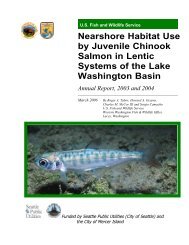2006 Water Comprehensive Plan - City of Bellevue
2006 Water Comprehensive Plan - City of Bellevue
2006 Water Comprehensive Plan - City of Bellevue
- No tags were found...
You also want an ePaper? Increase the reach of your titles
YUMPU automatically turns print PDFs into web optimized ePapers that Google loves.
from the point <strong>of</strong> supply to the point <strong>of</strong> use. The choice <strong>of</strong> method will also need to considerthe specific locations and capacities <strong>of</strong> future regional supply inlets, currently unknown.A mix <strong>of</strong> building new storage and constructing system improvements to access surplus EastOperating Area storage should also be considered. This would involve building only aportion <strong>of</strong> the required storage and scaling back the scope <strong>of</strong> the system improvement workto provide less capacity and therefore access to a lower volume <strong>of</strong> East Operating Areastorage.• The addition <strong>of</strong> new storage should be coordinated with the water quality goals <strong>of</strong> the<strong>Bellevue</strong> water system. Storage capacity significantly in excess <strong>of</strong> that needed has anegative impact on water quality, causing water age to increase and chlorine residuals todecrease. New storage should not be constructed in increments that cause large short-termexcesses.SUPPLY INLET CAPACITY ANALYSISThis section evaluates existing and future inlet capacity requirements for <strong>Bellevue</strong>’s watersystem. System demands and hydraulic model parameters are in accordance with the criteriasummarized in Chapter 4. Population forecasts as provided by the <strong>Bellevue</strong> <strong>Plan</strong>ningDepartment were used for the analysis. These forecasts, developed for each pressure zone, willresult in precise demand projections and service requirements.Evaluation <strong>of</strong> Supply Inlet CapacityOperating AreasEvaluation <strong>of</strong> existing and future inlet capacity needs was also accomplished by evaluating thethree hydraulic operating areas <strong>of</strong> the <strong>Bellevue</strong> water system. Each <strong>of</strong> these operating areascontains one or more primary pressure zones with several regional supply inlets. These primarypressure zones in turn supply water to several secondary pressure zones within the sameoperating area via pump stations and PRVs.Discussion <strong>of</strong> Inlet Capacity Analysis ResultsInlet capacity was evaluated in the 1998 <strong>Water</strong> <strong>Comprehensive</strong> <strong>Plan</strong>. As discussed in the 1998plan, only the West Operating Area was predicted to be deficient for both the year 2017 and forbuild-out conditions. This deficiency is again predominantly due to large increases in demanddue to significant growth forecasted for downtown <strong>Bellevue</strong>. Both the East and South OperatingAreas will have surplus inlet capacity through build-out.As part <strong>of</strong> this <strong>Water</strong> <strong>Comprehensive</strong> <strong>Plan</strong> update, a more in-depth inlet capacity analysis wascompleted. <strong>Bellevue</strong>’s primary objectives for inlet supply to each operating area are:• Provide sufficient capacity to meet maximum day demands.• Provide sufficient capacity to meet average day demand with any single inlet out <strong>of</strong>service.8-14
















